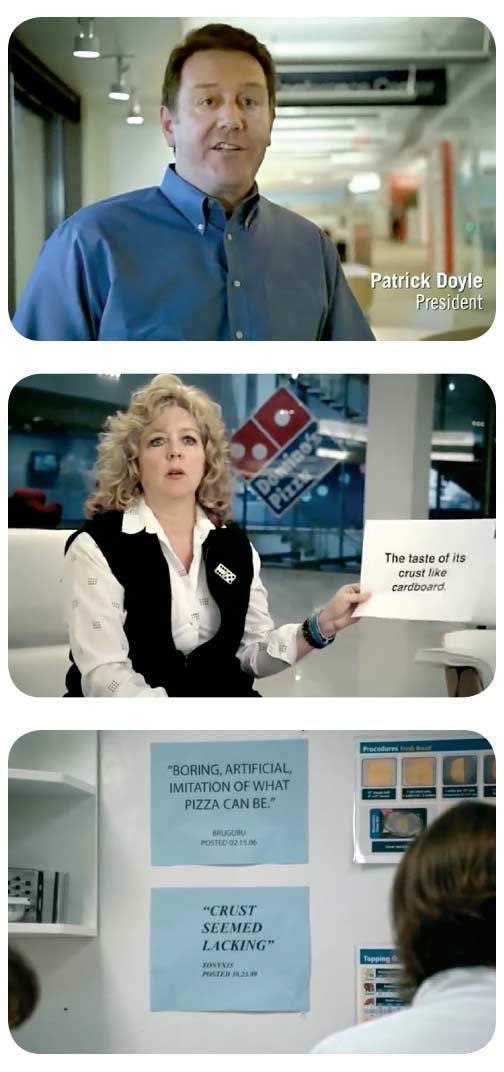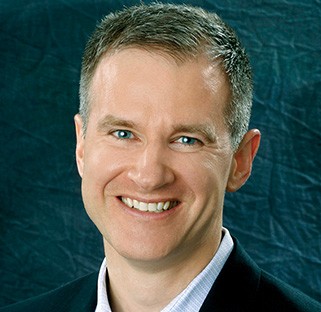Domino’s Digital Growth
Sometimes it takes a full-blown crisis to wake a company up. A stock price plunging to the floor, customers in revolt—the stuff of every executive’s nightmares. But great leaders do not just manage crises; they convert them into opportunities.
Take Domino’s, the world’s second-largest franchised pizza chain. The Great Recession was not kind to the company. Its stock dropped nearly 90 percent over 18 months, hitting an all-time low in late 2008. Around the same time, executives at the company’s Ann Arbor, Michigan, headquarters discovered they had an even more basic problem: People hated their pizza.
“Domino’s pizza crust, to me, is like cardboard,” said one woman in a 2009 focus-group video. On Twitter, the jabs were equally pointed. “It’s like cardboard with ketchup and cheese on it,” wrote one customer. “I quite honestly think I am about to puke,” tweeted another.
Tough words, but they inspired a customer-focused transformation. And that transformation, which began in late 2008, has made the company a digital business leader, driving 20 consecutive quarters of same-store sales growth and stoking a fiftyfold jump in its stock price. More than half of Domino’s worldwide sales now come through digital channels Share on X, and half of those originate on mobile devices. Applause App Quality Inc., which rates consumer satisfaction with mobile applications, awarded the Domino’s mobile app its top rating in 2016 in the fast-food category by a significant margin over its closest competitor.
Says Chief Digital Officer Dennis Maloney: We transitioned from being a pizza company to a tech company that happens to make pizza.
Eating Humble Pie
Such massive change started with four little words: “Oh Yes We Did.” That was the slogan Domino’s adopted when it committed to a crust-to-cheese overhaul in the wake of biting customer criticism. “Oh Yes We Did” was more than just an advertising tagline; it was a vow never to let up in the quest to improve customer experience. Domino’s would become what Mr. Maloney calls “a work-in-progress brand.”
“Once you start driving thinking like that into the organization, it becomes almost a mantra,” he says.
The company’s earlier complacency was somewhat understandable. By 2008, the fast-food firm that had begun nearly 50 years earlier as a small storefront in Ypsilanti, Michigan, had grown to nearly 9,000 outlets around the globe with revenues of $1.4 billion (it is now up to $2.2 billion). Domino’s owned the largest share of the pizza-delivery market. It was perhaps best known for its audacious guarantee of half-hour delivery, an advantage that no other fast-food chain had been able to match at such scale.
“Oh Yes We Did” was more than just an advertising tag line; it was a vow never to let up in the quest to improve customer experience.
But in building a world-class logistics operation, the company had taken its eye off the ball. “Customers looked at us as being very good at delivering pizza, but we did not rank very well in the area that mattered most to us, which was taste,” says Mr. Maloney, who arrived at Domino’s in 2010.
With social media taking customer criticisms public on a global scale, the company’s taste problem had to be dealt with. While some companies in this new media environment tried to squelch negativity or relegate it to the customer service department, Domino’s chose to address the problem head-on.
 Executives, chefs, and product managers were convened to scrutinize focus-group tapes and invent new ways to improve the customer experience. Copies of critical tweets were even posted on walls, so employees would come face-to-face with them when they were at the coffee machine. The message was clear: Customer satisfaction was everything.
Executives, chefs, and product managers were convened to scrutinize focus-group tapes and invent new ways to improve the customer experience. Copies of critical tweets were even posted on walls, so employees would come face-to-face with them when they were at the coffee machine. The message was clear: Customer satisfaction was everything.
But then came the viral video. As Domino’s was in the midst of its customer-focused overhaul in April 2009, two employees at one of its North Carolina restaurants posted a video online that showed one of them sneezing onto food and stuffing shredded cheese up his nose. The subsequent storm of negative publicity prompted an abject YouTube apology from then-president of Domino’s USA J. Patrick Doyle—and provided more fuel for the reinvention campaign.
The incident showed that social media could burnish a brand as much as damage it. Getting people to talk up the brand to each other was more powerful than anything a company could say about itself. “I didn’t have to convince anybody of the power of social media from that point forward,” says Mr. Maloney, who now oversees Domino’s presence on nearly every major social platform.
Still smarting from the sting of the viral video experience, then-CEO David Brandon placed a bet that was perhaps unprecedented in the history of advertising. In late 2009 Domino’s introduced its new pizza recipe in a multichannel campaign that promoted the worst jibes of its critics. TV spots paired snarky focus-group comments with some of the most vicious tweets. Domino’s launched a site, pizzaturnaround.com, to document its own transformation. Visitors could see clips from the focus-group tapes. “It’s hard to recall another recent ad in which a company self-flagellates with so much gusto,” Slate.com columnist Seth Stevenson wrote at the time.
It is also hard to recall an ad that was so right for its time. With the financial industry still reeling from scandal and automakers pleading for government bailouts, “facing the problems head-on was the perfect approach,” Mr. Maloney says. The ads were a hit, underscoring a new era of corporate transparency that was emerging in the aftermath of the social media revolution.
When Mr. Brandon left in early 2010, the same executive who had been selected to address the North Carolina incident a year earlier took over. Mr. Doyle wasted no time in making “Oh Yes We Did” the official corporate reinvention slogan, underscoring an unwavering commitment, in Mr. Maloney’s words, “to think the unthinkable.”
Order ‘AnyWare’
As Mr. Maloney and other executives worked to push change through the company, they could not help but see the growing incursion of technology into every aspect of customers’ lives as a huge growth opportunity.
In 2010, smartphones were beginning to be a ubiquitous phenomenon. Domino’s leadership saw this sea change as addressing the most entrenched barrier to growth in the pizza-delivery business: getting people to order more pizza. “We could see that we needed to build the digital channel in a fast and potent way, because there was going to be consolidation and the winners would be established early,” Mr. Maloney says.
With the overhaul of its recipe, Domino’s leadership was confident they had solved the quality problem. The next big challenge was to make ordering so drop-dead simple, across so many channels, that customers would not think twice about it. The pizza market is frequency-driven; people will only pay so much for a pizza. “There isn’t a lot of loyalty in this industry,” Share on X Mr. Maloney says. So “there’s a huge upside to driving frequency.”
That goal is behind Domino’s digital strategy. Its “Piece of the Pie” loyalty program rewards customers for making more, rather than bigger, purchases. Under an initiative called AnyWare, you can order a pizza using just about anything with a power source: by text message, tweet, Samsung Smart TV, or smartwatch. You can speak your wishes to an Amazon Echo. If you drive a Ford with the SYNC AppLink, it will take your spoken preference. Or tell it to Dom, a Siri-like personal assistant that speaks only pizza.
As part of AnyWare, the company challenged digital designers with the requirement that every app should be capable of ordering any one of millions of possible combinations of crust, sauce, and toppings no matter the platform. With one-third of its headquarters staff devoted to digital platforms, the company is determined to meet customers wherever they are and make ordering as easy as pie.
Case in point: You can now order Domino’s pizza by doing absolutely nothing. The Zero Click app, introduced in April, automatically places an order 10 seconds after the user launches it. Technically, the app requires one tap to load, but thereafter the process is automatic, assuming that the customer has already set up an “Easy Order” option.
Innovations like Zero Click came about because employees were pushed to think beyond the familiar, Mr. Maloney says. The concept sprang from a brainstorming meeting with one goal, he recalls: “Stretch the idea of simplifying the ordering process to the breaking point. When someone asked if we could make it possible for people to order without doing anything at all, that meeting came to a screeching halt.” Apple and Google app store officials would later say they had never seen anything like it.
Then there are drones. While Amazon was the first company to publicize the idea of delivery by drone, Domino’s is racing to be the first to make it reality. A pilot drone delivery service was due to be tested in New Zealand in late 2016, literally putting a pie in the sky. Another idea now being tested: using satellites to track customers as they approach stores to pick up their orders. That means employees can pop the pizza into the oven at the last possible minute to maximize freshness at pickup.
Unafraid of Failure
Driving all these tech innovations is the adoption of a tech company mindset that is nimble and views failure as a learning experience, not a source of shame. “We really do believe that failure is an option,” Mr. Maloney stresses. “We encourage our team members and agencies to challenge convention and look at ideas and technologies that have the potential to make step-change improvements in the consumer experience, even if they are a little scary to consider.”

While listening across all social channels to what customers want, Domino’s moves quickly to test, evaluate and adjust. “Digital provides very easy feedback loops,” Mr. Maloney says. “When you prove out the value of one investment, it leads to another, and that becomes a snowball effect.” Because products like smartphone apps can reach millions of people in a matter of days through word-of-mouth, “working in the digital space allows very small groups of people to solve very large problems very quickly,” Mr. Maloney says. “Once other people in the company see that kind of speed and agility, it becomes aspirational,” and others climb on board.
Top-level support is also crucial for Domino’s digital reinvention. Mr. Doyle and other members of the corporate leadership team are regularly briefed on all aspects of digital business-related projects and strategies. “There really isn’t anyone in this brand that isn’t impacted by our digital efforts,” Mr. Maloney says.
Ultimately, the transformation process is stoked by a vision that starts with a higher goal: putting the customer at the center. “We are focused on what our customers want, are asking for and responding to,” Mr. Maloney says. “That focus is helping the transition to a digital-first mentality for the entire company.” Embracing that mentality also means discarding assumptions about competition. In the same way that Airbnb has disrupted the hospitality industry without owning any hotels, competitors these days can come from anywhere. “We have to be playing at the speed of Silicon Valley companies, because if we don’t, one will become our competitor,” Mr. Maloney says.
“Oh Yes We Did” is a mantra of perpetual improvement inspired by the relentless march of new digital platforms. The need for change never ends. Musing about his decision to join the company six years ago, Mr. Maloney recalls with humor one of his initial hesitations. “I was a little worried about being bored in two years,” he says. “But now I’ve got a list the length of my arm of things we want to do.”




